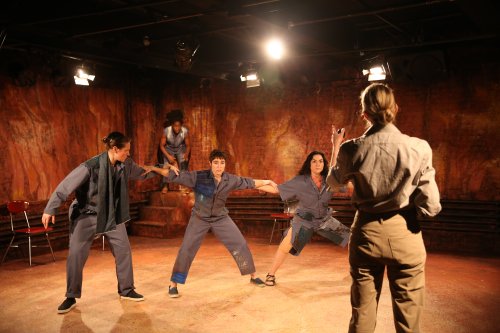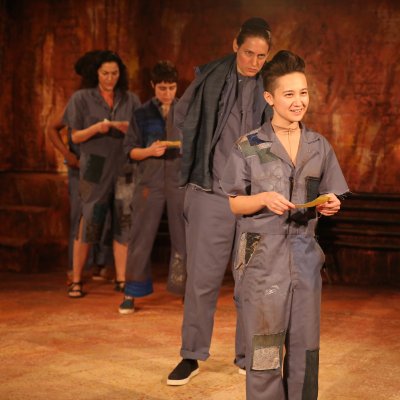Bundle of Sticks
Five gay men subject themselves to some unusual conversion therapy in this unique and imaginative tale.

Fleece, Hope Ward, Melissa Navia, Lucille Duncan and Laura Jordan in a scene from J. Julian Christopher’s “Bundle of Sticks” at INTAR Theatre (Photo credit: Carol Rosegg)
[avatar user=”Christopher Caz” size=”96″ align=”left” ] Christopher Caz, Critic[/avatar]
Coober Pedy is a unique southern Australian town known for being the “opal capital of the world” and for the fact that the majority of its citizens reside in underground holes, or “dugouts,” in order to avoid the scorching daytime temperatures. As of its last census, ~17% of the population are made up of the indigenous Aboriginal or Torres Strait Islander people.
Bundle of Sticks takes place in Coober Pedy, in “The Sticks”, an underground conversion therapy center. Five gay men from different parts of the world have come to The Sticks for conversion, with varying degrees of conviction. The characters:
Francisco – a Dominican
Abram – a Russian Jew
Gregos – Greek
Gemi – Indonesian
Otto – Australian, runs The Sticks
Tyree – American
One of the most interesting attributes of this play (apart from the clever title being a less common and unharmful definition of the word “faggot”) is playwright J. Julian Christopher’s insistence that none of the characters be portrayed by cisgendered men. The most significant effect of this casting is demonstrated in scenes when the men are supposed to be naked and interacting with each other in sexual ways. Where true male nudity and sexual touching would have simply been gratuitous and distracting, clever costuming (presumably) provided by production designer Meghan E. Healey has the characters wearing body suits, onto which sequined phalluses and scrotums of different colors and sizes have been sewn. Each suit sports a large nipple and a heart as well. The depiction of sex and sexuality thus become representational and symbolic, allowing the play and its language to proceed unimpeded by gawking.
Francisco is determined to convert, and wears bandages on his wrists from a suicide attempt which brings him to The Sticks for the second time. Melissa Navia plays the role with an earnest, keen sense of desperation and honesty.
Fleece brings an oafish sweetness to the part of Abram, a conservative Jew who is hesitant to change, only wishing to do so for his wife and religion.

Lucille Duncan, Zo Tipp and Hope Ward in a scene from J. Julian Christopher’s “Bundle of Sticks” at INTAR Theatre (Photo credit: Carol Rosegg)
Lucille Duncan finds humor in the easy manliness of Gregos, the mouth-watering Greek sporting the biggest set of sequined jewels and who is the object of the other men’s lust.
Gemi (Zo Tipp) is the effeminate lover of Tyree, and has only come to conversion therapy to win back his parents’ love and approval. Tipp brings a rebellious urgency to the part, but could do well to vary her expressions and break away from her default wincing smile of skepticism.
Hope Ward plays the war veteran Tyree with a simple, sensitive masculinity, and claims to have come to the conversion center only to rescue Gemi, but Gemi is skeptical given the existence of Tyree’s wife Samantha.
Finally, Laura Jordan rounds out the cast in the thankless role of Otto, a churlish condescending bully who runs the conversion program without an ounce of science. This flat character’s lines have been overstuffed with so many euphemisms and slang terms for homosexuals and male genitalia that Jordan is afforded no opportunity to display any humanity whatsoever, which I suppose could be the point, but it leaves Jordan nothing to act with but a big stick.
The considerable talent of the remaining cast especially shines when they take on their smaller, secondary parts, portraying others in flashback scenes, with subtlety and fine characterization. Standout examples include Duncan’s brief turn as the smoky and steamy American stranger who is caught having sex with Francisco. In a later scene where she (as Gregos) performs in drag as Vasílissa Ravdión, she is sensitive, vulnerable and earnest, as is Fleece, who plays the woman who would be Gregos’ wife, almost unrecognizable as the same actor who plays Abram.

Lucille Duncan, Melissa Navia, Fleece and Zo Tipp in a scene from J. Julian Christopher’s “Bundle of Sticks” at INTAR Theatre (Photo credit: Carol Rosegg)
These same actors also unify on occasion to become a Rainbow Serpent, which slithers in and out of Christopher’s script, making commentary and participating in the proceedings in mystical ways. It is suggested that this serpent, borrowed from Australian Aboriginal mythology, identifies with various genders and sexualities, a notion which art historian Georges Petitjean suggests is the reason the rainbow flag has been adopted as the symbol of lesbian, gay, bisexual, and transgender communities. The use of the serpent in the script seems somewhat artsy and non-essential to the conflicts these five men are experiencing but its inclusion in this tale is a bold and interesting choice.
When the five men have had enough of Otto’s cruel manipulations, their pushback reaches its peak in the form of accusations against Otto for being a descendant of Walter Nairn, an Australian politician who defended police and settlers in the Forrest River massacre of June 1926, where Indigenous Australian people were killed by law enforcement personnel and civilians. While this historic event is compelling, Otto’s condemnation by association to his grandfather for this massacre does not seem to be a fit punishment for his crime of treating the men inhumanely for their homosexuality.
Director Lou Moreno gets ample credit for shaping this piece well and pulling out some sincere ensemble work from the actors. The scene design by Meghan E. Healey is unremarkable, unsurprising given the setting of a hole in the ground.
Ultimately, the men and the serpent defeat Otto together, and some expendable moments and dialogue aside, Bundle of Sticks engages the audience with humor and imagination, culminating in joyous freedom for the men and their natural desires.
Bundle of Sticks (through March 12, 2020)
INTAR Theatre and The Radio Drama Network
INTAR Theatre, 500 West 52nd Street at 10th Avenue, 4th floor, in Manhattan
For tickets visit https://www.intartheatre.org/home
Running time: two hours including one intermission






Leave a comment